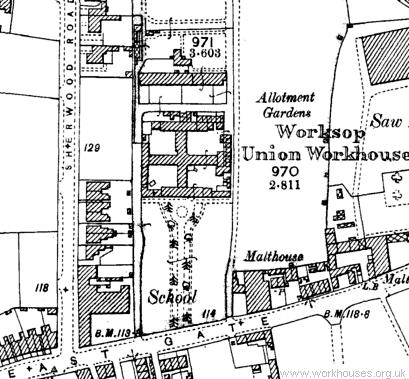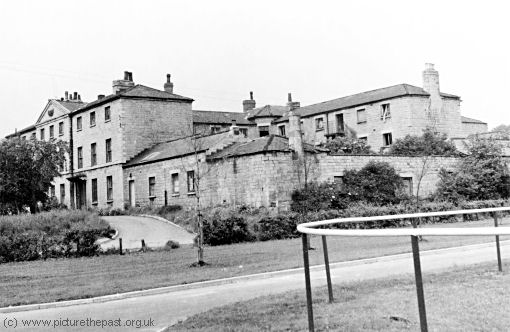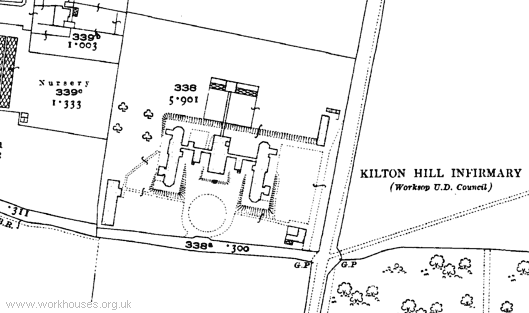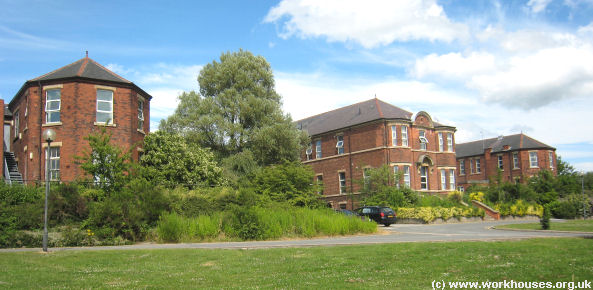Worksop Union, Nottinghamshire
Up to 1834
Eden, in his 1797 survey of the poor in England, reported that:
In 1835, Worksop's workhouse stood on Lead Hill in an area popularly named "Bedlam Square."
After 1834
The Worksop Poor Law Union formally came into being on 2nd July 1836. Its operation was overseen by an elected Board of Guardians, 29 in number, representing its 26 constituent parishes as listed below (figures in brackets indicate numbers of Guardians if more than one):
County of Nottingham:
Blyth, Carburton, Carlton-in-Lindrick, Cuckney, Harworth, Hodsock, Holbeck, Nether Langwith, Norton, Styrrup, Worksop (3).
Later additions (all from 1862): Wallingwells, Welbeck, Woodhouse Hall.
County of Derby:
Barlborough, Clown, Elmton, Whitwell (2).
County of York:
Anston-cum-Membris, Dinnington, Firbeck, Gildingwells, Harthill and Woodhall, Letwell, St John's with Throapham, Thorpe Solvin, Todwick, Wales, Woodsetts.
The population falling within the Union at the 1831 census had been 16,111 — ranging from St John's with Throapham (population 70) to Worksop itself (5,566). The average annual poor-rate expenditure for the period 1833-35 had been £6,165 or 7s.8d. per head.
The new Worksop Union workhouse was built in 1837 at the north side of East Gate in Worksop. Its architect is unknown but the layout followed the popular cruciform plan with an impressive three-storey entrance facade. The Poor Law Commissioners authorised an expenditure of £4,000 on its construction which was to accommodate 400 inmates. The workhouse location and layout are shown on the 1898 map below.

Worksop workhouse site, 1898.

Worksop workhouse from the south-east, c.1964.
© Nottinghamshire Local Studies and www.picturethepast.org.uk.
In around 1900, the union removed all children from the workhouse and opened two homes, one for girls at "Abbeyhurst", 55 Cheapside, and one for boys at "Yew Tree Villa", 90 Cheapside.
During the 1926 miners' strike, the union's finances became overdrawn by a massive £70,000. However, four years later, at the Guardians' final meeting in March 1930, the Board congratulated themselves in paying off the 1926 debt, and leaving a balance of £1,623. A farewell social event was held at the Royal Hotel on the 27th March 1930.
The workhouse buildings were demolished in around 1965.
Kilton Hill Infirmary
In 1901-4, the Worksop Union erected an infirmary at an eleven-acre site on Kilton Hill. The official laying of the foundations stone took place on 1st January 1902 by Mr Sydney Smith, JP, Chairman of the Guardians. It was designed by Herbert C Scapling and the construction work was carried out by JH Vickers Ltd at a contract price of £15,490. Its location and layout are shown on the 1920 map below.

Worksop Kilton Hill Infirmary site, 1920.
The infirmary, which could accommodate 84 patients, was a typical pavilion-plan design with male and female pavilions separated by a central administrative block.

Kilton Hill hospital from the south-west, 2009.
© Peter Higginbotham.
By 1920, the infirmary had apparently been taken over by the Worksop Urban District Council. The site is now part of Bassetlaw Hospital.
Children's Homes
The Worksop Union established two children's homes in Worksop — one known as 'Abbeyhurst', at 55 Cheapside, and the other, for girls only, at 37 Potter Street. In 1924, the combined capacity of the two homes was 49 places.
Both properties still exist, now with other uses.
Staff
Inmates
Records
Note: many repositories impose a closure period of up to 100 years for records identifying individuals. Before travelling a long distance, always check that the records you want to consult will be available.
- Nottinghamshire Archives and Southwell Diocesan Record Office, County House, Castle Meadow Road, Nottingham NG2 1AG. Holdings include: Guardians' minute books (1848-1930); Children's Home register (1901-30); etc.
Bibliography
Links
Acknowledgment
- Archive picture is by kind permission of www.picturethepast.org.uk and Nottinghamshire Local Studies.
Unless otherwise indicated, this page () is copyright Peter Higginbotham. Contents may not be reproduced without permission.


